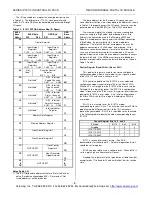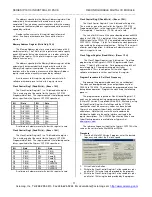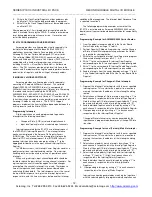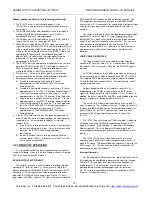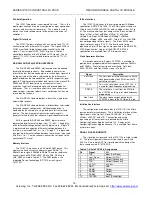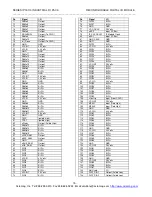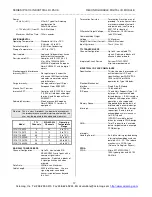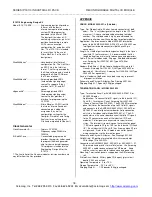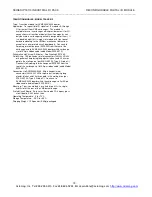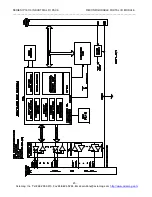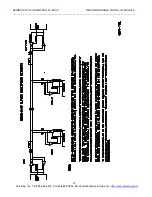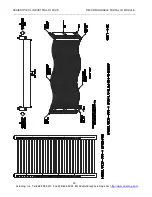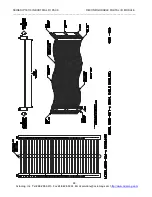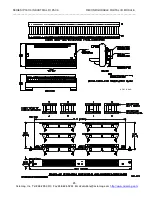
SERIES IP1K110 INDUSTRIAL I/O PACK RECONFIGURABLE DIGITAL I/O MODULE
__________________________________________________________________________________________
- 12 -
Acromag, Inc. Tel:248-295-0310 Fax:248-624-9234 Email:solutions@acromag.com
http://www.acromag.com
5.
Write to the Clock Control Register 3 at base address plus
an offset of 1DH using the data provided by the program.
6.
Write 1H to the Clock Trigger Register at base address plus
an offset of 1FH.
After approximately 1.2ms, programming is complete and the
clock is available for use by the FPGA. A software or hardware
reset during programming will cause errors. If a reset occurs,
restart the above procedure.
IP1K110 PROGRAMMING CONSIDERATIONS
Acromag provides a software product (sold separately) to
facilitate the development of Windows (98/Me/2000/XP
)
applications accessing Industry Pack modules installed on
Acromag PCI Carrier Cards and CompactPCI Carrier Cards.
This software (Model IPSW-API-WIN) consists of low-level
drivers and Windows 32 Dynamic Link Libraries (DLLS) that are
compatible with a number of programming environments
including Visual C++, Visual Basic, Borland C++ Builder and
others. The DLL functions provide a high-level interface to the
carriers and IP modules eliminating the need to perform low-level
reads/writes of registers, and the writing of interrupt handlers.
IP MODULE VxWORKS SOFTWARE
Acromag provides a software product (sold separately)
consisting of IP module VxWorks
libraries. This software
(Model IPSW-API-VXW MSDOS format) is composed of
VxWorks
(real time operating system) libraries for all Acromag
IP modules and carriers including the AVME9670,
AVME9660/9630, APC8620/21, ACPC8630/35, and ACPC8625.
The software is implemented as a library of “C” functions which
link with existing user code to make possible simple control of all
Acromag IP modules and carriers. The IP1K110 support
programs implement the transfer of developed code between the
user’s processor and the Altera FPGA.
Programming Interrupts
Digital input channels can be programmed to generate
interrupts for the following conditions:
•
Change-of-State (COS) at selected input channels.
•
Input level (polarity) match at selected input channels.
Interrupts generated by the IP1K110 use interrupt request
line INTREQ0
∗
(Interrupt Request 0). The interrupt release
mechanism employed is the Release On Register Access
(RORA) type. This means that the interrupter will release the
Industrial I/O Pack interrupt request line (INTREQ0) after all
pending interrupts have been cleared by writing a “1” to the
appropriate bit positions in the input channel Interrupt Status
Register.
In VMEbus systems, the Interrupt Vector Register contains a
pointer vector to an interrupt handling routine. One interrupt
handling routine must be used to service all possible channel
interrupts.
When using interrupts, input channel bandwidth should be
limited to reduce the possibility of missing channel interrupts. For
a given input channel, this could happen if multiple changes
occur before the channel’s interrupt is serviced. The response
time of the input channels should also be considered when
calculating this bandwidth. The total response time is the sum of
the input buffer response time, plus the interrupt logic circuit
response time, and this time must pass before another interrupt
condition will be recognized. The Interrupt Input Response Time
is specified in section 6.
The following programming examples assume that the
IP1K110 is installed onto an Acromag AVME9630/9660 carrier
board (consult your carrier board documentation for compatibility
details).
Programming Example for AVME9630/9660 Carrier Boards:
1. Clear the global interrupt enable bit in the Carrier Board
Status Register by writing a “0” to bit 3.
2. Perform Specific IP Module Programming - see the Change-
of-State or Level Match programming examples that follow,
as required for your application.
3. Write to the carrier board Interrupt Level Register to program
the desired interrupt level per bits 2, 1, & 0.
4. Write “1” to the carrier board IP Interrupt Clear Register
corresponding to the IP interrupt request(s) being configured.
5. Write “1” to the carrier board IP Interrupt Enable Register bits
corresponding to the IP interrupt request to be enabled.
6. Enable interrupts from the carrier board by writing a “1” to bit
3 (the Global Interrupt Enable Bit) of the Carrier Board Status
Register.
Programming Example for Change-of-State Interrupts:
1. Program the Interrupt Vector Register with the user specified
interrupt vector. This vector forms a pointer to a location in
memory that contains the address of the interrupt handling
routine.
2. Select channel Change-of-State interrupts by writing a “1” to
each channel’s respective bit in the Interrupt Type Register.
Note that Change-Of-State interrupts (specified with “1”) may
be mixed with polarity match interrupts (specified with “0”).
3. Enable individual input channel interrupts by writing a “1” to
each channel’s respective bit in the Interrupt Enable Register.
4. Clear pending interrupts by writing a “1” to each channel’s
respective bit in the Interrupt Status Register.
Change-of-State Interrupts may now be generated by the
input channels programmed above for any Change-Of-State
transition.
Programming Example for Level (Polarity) Match Interrupts:
1. Program the Interrupt Vector Register with the user specified
interrupt vector. This vector forms a pointer to a location in
memory that contains the address of the interrupt handling
routine.
2. Select channel polarity match interrupts by writing a “0” to
each channel’s respective bit in the Interrupt Type Registers.
Note that Change-Of-State interrupts (specified with “1”) may
be mixed with polarity match interrupts (specified with “0”).
3. Select the desired polarity (High/Low) level for interrupts by
writing a “0” (Low), or “1” (High) level to each channel’s
respective bit in the Interrupt Polarity Registers.
4. Enable individual input channel interrupts by writing a “1” to
each channel’s respective bit in the Interrupt Enable
Registers.
5.
Clear pending interrupts by writing a “1” to each channel’s
respective bit in the Interrupt Status Register.
Interrupts can now be generated by matching the input level
with the selected polarity for programmed interrupt channels.








